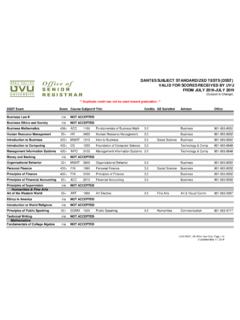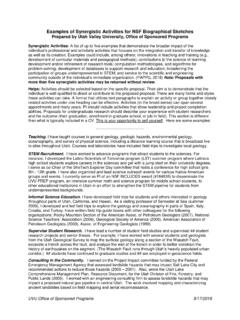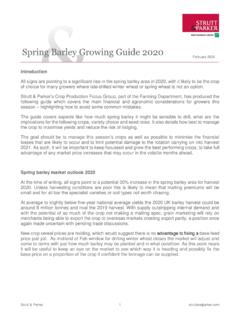Transcription of Dry Etching (1) - Utah Valley University
1 Dry Etching Definition Etching : A process of removing material from substrate or film s surface Anisotropic: An etch profile that has a straight vertical wall Isotropic: An etch profile that has a curve wall Critical Dimension (CD): Using the current technology, the smallest possible geometric structure (width of the interconnected line, contacts, trenches, etc.) that can be form. ( +dimension%2C+CD) Plasma: The fourth state of matter generated with high heat or sending in a high electrical voltage into gas.
2 Selectivity: The different in in etch rate between the etch surface and the resist or the layer underneath the surface. Undercut: The result when during the Etching process, part of the substance removed were underneath the film Avalanche: When the secondary free electron collided with twenty or more molecules after it is energized Cathode: An electrode that have negative charge. This is where the electron entered into the system Anode: An electrode that have a positive charge. Introduction Etching is a process of removing material from the substrate s surface.
3 In general, there are two categories that Etching can be divided into dry Etching , and wet Etching . The focus of this section will be solely on dry Etching . Wet Etching , a process where the substrate is submerged into aqueous chemical to be edged will later be discussed in other section. Benefit and Disadvantage of Dry Etching There are numerous benefits toward dry Etching . Some benefits included less waste that needs special disposal, better critical dimension control (less undercut due to anisotropic nature of dry Etching ), cleaner surfaces, and reduced in corrosion of metal feature of the substrate; however, there is some inconvenience in using dry Etching in that it required specialized equipment to handle the plasma and the reactive gas.
4 What is Dry Etching ? Dry Etching is a process of removing material from the surface via plasma or reactive gases. As the name suggested, after the etched have finished, the substrate s surface, which have been etched, will remain dry. In dry Etching , surfaces are removed through physical mean via bombardment of vapor or gas, chemically through reaction between the reactive species and the surface, or the combination of both physical and chemical reaction. Here is a brief overview of each of the technique, which will be discussed later in the section.
5 Physical sputter/ion Etching and ion-beam milling (IBM) Etching is caused from the transfer of momentum between the Ar+ gases and the Etching surface. This process is completely physical process. Chemical Plasma Etching (PE) Plasma is the supplier of the gaseous neutral atom that will react with the surface of the substrate. Upon contacting the surface that will be removed, the neutral atom will diffuse with the surface, creating volatile product which is then removed. The result is an etch surface. Chemical/Physical Etching or reactive ion Etching (RIE) The substrate surface is etched away through both physical and chemical technique mentioned above.
6 What to Considered When Choosing a Technique There are two main factors that must be considered when choosing different dry Etching technique. The first is the etch profile, and the second is the selectivity. Etch profile refers to what type of surface will result from the etched process such as anisotropic or isotropic features, directional vs non-directional, and vertical features. For example, physical Etching techniques will form a semi anisotropic or perfect anisotropic feature, where as PE caused isotropic etch, resulting in undercut; however, a combination of physical and chemical etch (such as the RIE) will result in a perfect isotropic feature.
7 Another example that can be considered is in the case of vertical etch. In vertical etch, if used a physical technique, a lot of over etch must be made over the same surface before the desired result can be accomplished; however, using PE, the high side wall can easily be removed due to its isotropic Etching nature. As a result, no over etch is required. Selectivity of the Etching surface mean the difference between the etch rate of the film that will be etch, the mask or resist that is covering it and the underlying layer of the film.
8 When Etching a surface, high selectivity is preferred as this could reduce the damage in the underlying surface below the surface that will be etch, or protect the resist from being damage (this is important as the resist cover the part of the surface that Etching should not occurred). Physical Etching as mentioned above can obtained closed to if not perfect anisotropic surface; however, it has poor selectivity, and low etch rate (imagine a sculptor sculpting a mountain, the sculptor tool will go through any layer of rock indiscriminately without control).
9 PE on the other hand can result in loss of critical dimension due to the undercut, but have great selectivity and is a fast process (chemical can only diffuse to certain surface to form volatile product). Then the RIE have the benefit and advantage of physical and chemical, it has fast etched rate, high selectivity, and result in perfect critical dimension. To accomplish desired selectivity, and etch profile, another factor that must be taken into account is the strength of the plasma. Factor that contributed to the strength of the plasma is the velocity of electron, average ion energy, density of electron, density of plasma ion, density of neutral species, and the density of ion current.
10 All the factors listed can be determined by the strength of the electric field, and the pressurization of plasma. The stronger the field, the greater the velocity of electron and ion, which increased their potential and kinetic energy. As pressure is increased, the mean free path is reduced, which lead to more collision between ions, electrons, and molecules, resulting in a lower velocity ions and electrons. The role of the ions is then to induce the chemical reaction between the reactive neutral species and the edging s surface.













